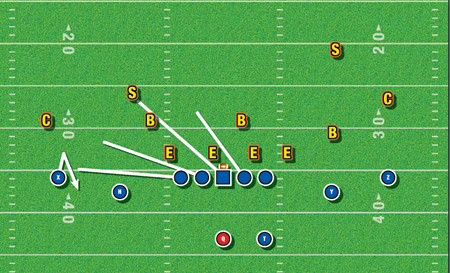Article CategoriesAFM Magazine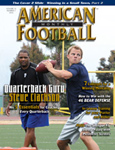
|
Two Plays in One - Shotgun Fly Sweep Fused with Perimeter Screensby: Rusty StiversOffensive Coordinator Modesto Junior College (CA) © More from this issue As an offensive coordinator, I want to run the ball north/south but have difficulties against some of the great teams we play. Protecting our quarterback can be problematic and the defensive backs we face make man-to-man situations an arduous task. After listening to Mike Bellotti, formerly of Oregon, speak about attaching screens to their running game, we decided to fuse the bubble screen with our inside and outside zones. The zone-bubble became two plays in one because we did not have to audible to either play (both were working simultaneously). Our quarterback would peek pre-snap at the #2 defender to see if he had the easy bubble (See Diagram 1). 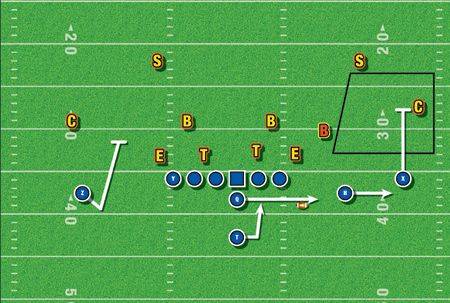

PHILOSOPHY CHANGE The idea of attaching the zone-bubble changed the entire philosophy of our offense. We went to a spread-and-screen offense in 2006 after being a multiple set, West Coast offense. As a junior college, we could not find/recruit fullbacks that we thought gave us the best five players on the field. The concept of running two plays in one became an alternative method to help us equalize the playing field. Running plays simultaneously, by having offensive players work in opposite directions, forced defenses to cover down and soften the box. We run various screens within this two-in-one concept and that has D- linemen more concerned with lateral movement than direct pressure in our backfield. The lateral concern gave us a better chance to run the ball north/south. GUN FLY SWEEP/TACKLE SCREEN We have combined a variety of plays with the idea of running two plays at once. In 2006, we experimented with the idea of running the Shotgun Fly Sweep and attaching our tackle screen to the backside. We decided the Shotgun Fly Sweep would involve five of our players (three receivers, a running back, and a tackle) and the backside tackle screen would involve five players (four linemen and a WR). The 11th player (QB) would pre-snap the best available play. TERMINOLOGY In doubles (our 44 formation), running the sweep to the right, the play is called “Freak 44 Temple”. “Freak” refers to the Fly Sweep going to the right (Freak). This alerts the receivers on the right, the running back, right tackle, and the slot who is running the sweep to the right (See Diagram 3). 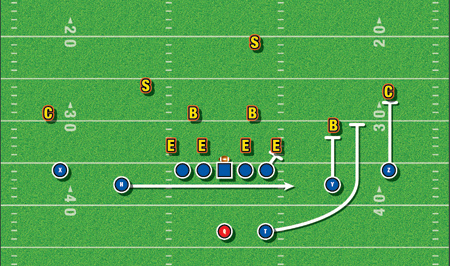
“Temple” refers to the tackle screen going to the left (Temple). This alerts the left WR and the four remaining linemen that they are involved in the left tackle screen (See Diagram 4). We teach our QBs to pre-snap the field for the Fly Sweep. We look for the #1 and #2 defenders to be blocked by our receivers. We tell our QB we want a soft #3 (inside linebacker or deep safety) for the running back to block. After a quick scan, he will look at the defensive end and determine if our tackle has an easy reach block. If the picture looks good to him pre-snap, he can hand the ball off on the fly sweep. If our QB reads a difficult #3 defender and/or a wide defensive end, he will throw the backside tackle screen. After the sweeper passes, the QB will drop back 4-5 steps and throw the backside screen. All of the offensive linemen’s initial steps are that of fly-sweep. The left tackle will run down the LOS towards the WR and block the corner (#1). The left guard will run to the flats and block #2. The center will hook to the curl area looking for #3. The right guard will run short to the hole and pick up the first defender that crosses his face (See Diagram 5). 
RECEIVER STEPS The screen receiver will burst up the field three yards and then retrace his steps. If the corner is soft, the receiver will sit and wait for the ball (See Diagram 6). 
If the corner is playing man, the screen receiver will sell the fade for three yards and then use his inside arm to engage the corner and use the momentum to separate back to the LOS. We want our receivers to retrace their steps first and then come down the LOS towards the tackle to help set up the block (See Diagram 7). 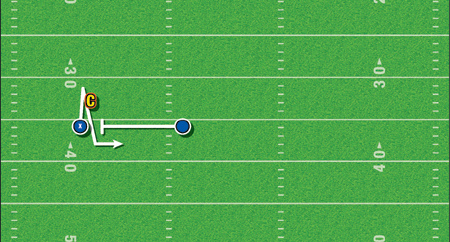
The use of two plays in one has been a major reason for the production of our offense. A pre-snap decision for our QB simplifies his decision making process and increases his confidence and efficiency with short passes. In 2006, our QB led the nation (junior college) in passing percentage (71.8%). In 2007 and 2008, we won back-to-back league championships for the first time in school history. We have continued to work on fusing plays that give us a better chance of moving the chains and competing against the talented teams in our area. |
|
| HOME |
MAGAZINE |
SUBSCRIBE | ONLINE COLUMNISTS | COACHING VIDEOS |
Copyright 2024, AmericanFootballMonthly.com
All Rights Reserved


